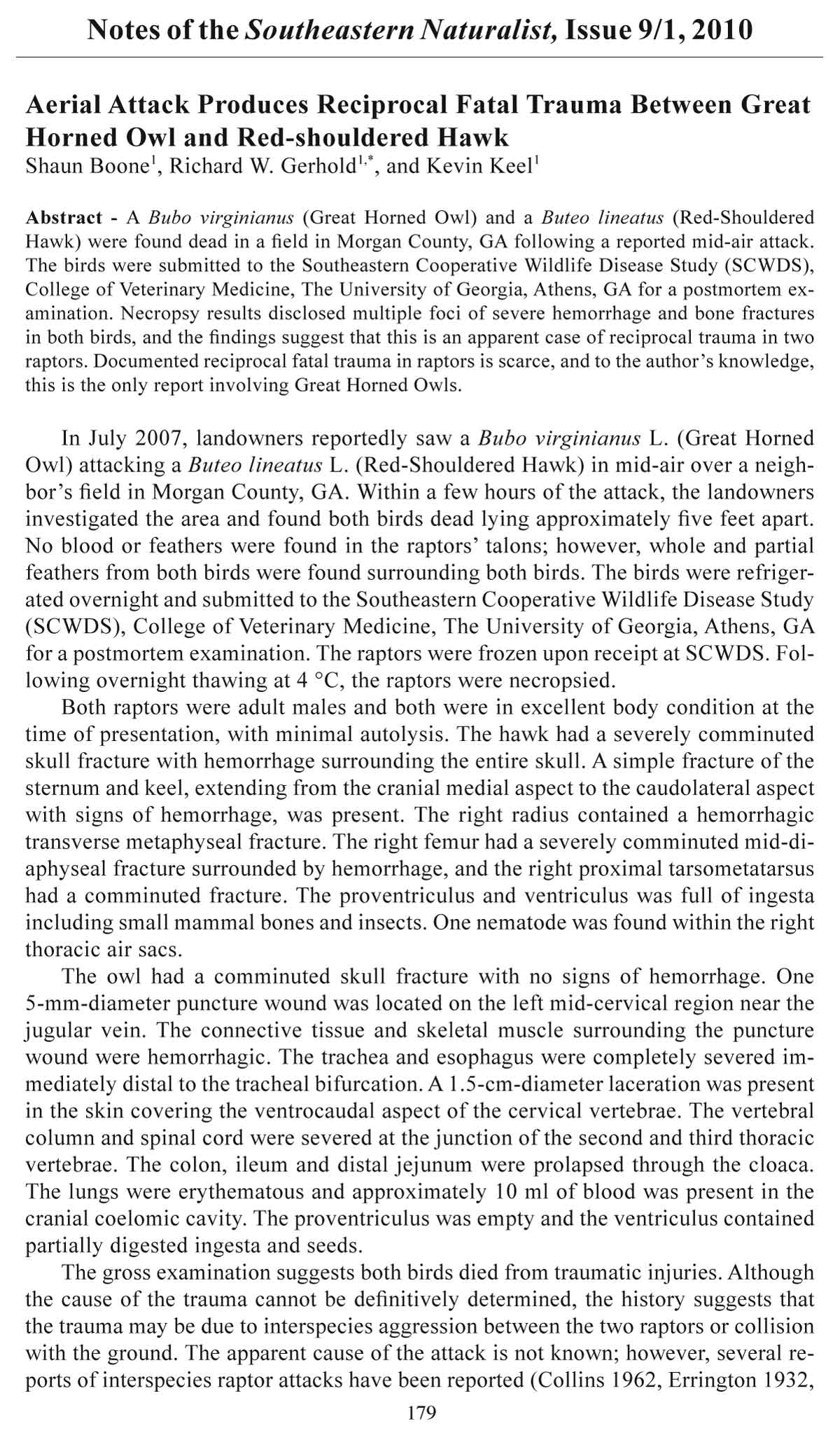Aerial Attack Produces Reciprocal Fatal Trauma Between Great
Horned Owl and Red-shouldered Hawk
Shaun Boone1, Richard W. Gerhold1,*, and Kevin Keel1
Abstract - A Bubo virginianus (Great Horned Owl) and a Buteo lineatus (Red-Shouldered
Hawk) were found dead in a field in Morgan County, GA following a reported mid-air attack.
The birds were submitted to the Southeastern Cooperative Wildlife Disease Study (SCWDS),
College of Veterinary Medicine, The University of Georgia, Athens, GA for a postmortem examination.
Necropsy results disclosed multiple foci of severe hemorrhage and bone fractures
in both birds, and the findings suggest that this is an apparent case of reciprocal trauma in two
raptors. Documented reciprocal fatal trauma in raptors is scarce, and to the author’s knowledge,
this is the only report involving Great Horned Owls.
In July 2007, landowners reportedly saw a Bubo virginianus L. (Great Horned
Owl) attacking a Buteo lineatus L. (Red-Shouldered Hawk) in mid-air over a neighbor’s
field in Morgan County, GA. Within a few hours of the attack, the landowners
investigated the area and found both birds dead lying approximately five feet apart.
No blood or feathers were found in the raptors’ talons; however, whole and partial
feathers from both birds were found surrounding both birds. The birds were refrigerated
overnight and submitted to the Southeastern Cooperative Wildlife Disease Study
(SCWDS), College of Veterinary Medicine, The University of Georgia, Athens, GA
for a postmortem examination. The raptors were frozen upon receipt at SCWDS. Following
overnight thawing at 4 °C, the raptors were necropsied.
Both raptors were adult males and both were in excellent body condition at the
time of presentation, with minimal autolysis. The hawk had a severely comminuted
skull fracture with hemorrhage surrounding the entire skull. A simple fracture of the
sternum and keel, extending from the cranial medial aspect to the caudolateral aspect
with signs of hemorrhage, was present. The right radius contained a hemorrhagic
transverse metaphyseal fracture. The right femur had a severely comminuted mid-diaphyseal
fracture surrounded by hemorrhage, and the right proximal tarsometatarsus
had a comminuted fracture. The proventriculus and ventriculus was full of ingesta
including small mammal bones and insects. One nematode was found within the right
thoracic air sacs.
The owl had a comminuted skull fracture with no signs of hemorrhage. One
5-mm-diameter puncture wound was located on the left mid-cervical region near the
jugular vein. The connective tissue and skeletal muscle surrounding the puncture
wound were hemorrhagic. The trachea and esophagus were completely severed immediately
distal to the tracheal bifurcation. A 1.5-cm-diameter laceration was present
in the skin covering the ventrocaudal aspect of the cervical vertebrae. The vertebral
column and spinal cord were severed at the junction of the second and third thoracic
vertebrae. The colon, ileum and distal jejunum were prolapsed through the cloaca.
The lungs were erythematous and approximately 10 ml of blood was present in the
cranial coelomic cavity. The proventriculus was empty and the ventriculus contained
partially digested ingesta and seeds.
The gross examination suggests both birds died from traumatic injuries. Although
the cause of the trauma cannot be definitively determined, the history suggests that
the trauma may be due to interspecies aggression between the two raptors or collision
with the ground. The apparent cause of the attack is not known; however, several reports
of interspecies raptor attacks have been reported (Collins 1962, Errington 1932,
Notes of the Southeastern Nat u ral ist, Issue 9/1, 2010
179
180 Southeastern Naturalist Notes Vol. 9, No. 1
Weigand 1967). Additionally, Great Horned Owls are known to prey on a wide variety
of animals and have taken prey as large as Herons (Johnsgard 2002). The lesions observed
in the Owl suggest the hawk’s talon may have punctured the owl’s jugular vein
and lacerated the trachea, potentially leading to exsanguination and asphyxiation. This
supposition is supported by the presence of copious amount of blood in the coelomic
cavity of the owl. Such an event likely would cause the owl to be unable to sustain fl ight
and subsequently collide with the ground. The fractured vertebral column and skull as
well as the prolapsed intestines in the owl may have been caused by blunt trauma from
collision with the ground. It may be expected that fractured bones due to the ground
collision would lack hemorrhage if the jugular was lacerated in fl ight and the majority
of blood had drained in the coelomic cavity, which was the case.
The presence of a hemorrhage surrounding the fractured hawk bones indicates
the lesions were premortem and may suggest that the fractures were due to the owl
attacking the hawk or by collision with the ground. Unlike the owl, the hawk’s vessels
were not severed, and thus fractures due to ground collisions may have resulted
in hemorrhagic fractures. Other causes for the bone fractures in both birds and the
intestinal prolapse observed in the owl could be potentially due to scavengers; however,
no teeth marks or lacerations were found in the skin of the head or surrounding
the vent. In conclusion, the findings suggest that this is an apparent case of reciprocal
trauma in two raptors.
Literature Cited
Collins, C.T. 1962. Red-tailed Hawk attacks Long-eared Owl. Wilson Bulletin 74:89.
Errington, P.L. 1932. An encounter between a Cooper’s Hawk and a Horned Owl. Wilson Bulletin
44:189.
Johnsgard, P.A. 2002. North American Owls Biology and Natural History. Second Edition.
Smithsonian Institution Press, Washington, DC. 298 pp.
Weigand, J.P. 1967. Ferruginous hawk attacks Great Horned Owl. Auk 84:433.
1Southeastern Cooperative Wildlife Disease Study, College of Veterinary Medicine, The University
of Georgia, Athens, GA 30602. *Corresponding author - rgerhold@uga.edu.














 The Southeastern Naturalist is a peer-reviewed journal that covers all aspects of natural history within the southeastern United States. We welcome research articles, summary review papers, and observational notes.
The Southeastern Naturalist is a peer-reviewed journal that covers all aspects of natural history within the southeastern United States. We welcome research articles, summary review papers, and observational notes.